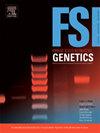Advances in forensic genetics: Exploring the potential of long read sequencing
IF 3.2
2区 医学
Q2 GENETICS & HEREDITY
引用次数: 0
Abstract
DNA-based technologies have been used in forensic practice since the mid-1980s. While PCR-based STR genotyping using Capillary Electrophoresis remains the gold standard for generating DNA profiles in routine casework worldwide, the research community is continually seeking alternative methods capable of providing additional information to enhance discrimination power or contribute with new investigative leads. Oxford Nanopore Technologies (ONT) and PacBio third-generation sequencing have revolutionized the field, offering real-time capabilities, single-molecule resolution, and long-read sequencing (LRS). ONT, the pioneer of nanopore sequencing, uses biological nanopores to analyze nucleic acids in real-time. Its devices have revolutionized sequencing and may represent an interesting alternative for forensic research and routine casework, given that it offers unparalleled flexibility in a portable size: it enables sequencing approaches that range widely from PCR-amplified short target regions (e.g., CODIS STRs) to PCR-free whole transcriptome or even ultra-long whole genome sequencing. Despite its higher error rate compared to Illumina sequencing, it can significantly improve accuracy in read alignment against a reference genome or de novo genome assembly. This is achieved by generating long contiguous sequences that correctly assemble repetitive sections and regions with structural variation. Moreover, it allows real-time determination of DNA methylation status from native DNA without the need for bisulfite conversion. LRS enables the analysis of thousands of markers at once, providing phasing information and eliminating the need for multiple assays. This maximizes the information retrieved from a single invaluable sample. In this review, we explore the potential use of LRS in different forensic genetics approaches.
法医遗传学的进展:探索长读测序的潜力。
自 20 世纪 80 年代中期以来,基于 DNA 的技术一直被用于法医实践。虽然使用毛细管电泳技术进行基于 PCR 的 STR 基因分型仍是全球常规案件工作中生成 DNA 图谱的黄金标准,但研究界仍在不断寻求能够提供更多信息的替代方法,以提高鉴别能力或提供新的调查线索。牛津纳米孔技术公司(ONT)和 PacBio 第三代测序技术为这一领域带来了革命性的变化,提供了实时功能、单分子分辨率和长序列测序(LRS)。ONT 是纳米孔测序技术的先驱,利用生物纳米孔实时分析核酸。它的设备为测序带来了革命性的变化,可能是法医研究和常规案件工作的一个有趣的替代方案,因为它体积小巧,具有无与伦比的灵活性:它的测序方法范围广泛,从 PCR 扩增的短目标区域(如 CODIS STR)到无 PCR 的全转录组甚至超长的全基因组测序。尽管与 Illumina 测序相比,该技术的错误率较高,但它能显著提高与参考基因组或全新基因组组装进行读数比对的准确性。这是通过生成长的连续序列来实现的,这些序列能正确地组装重复部分和具有结构变异的区域。此外,它还能实时测定原生 DNA 的 DNA 甲基化状态,而无需进行亚硫酸氢盐转换。LRS 可同时分析数千个标记,提供相位信息,无需进行多次检测。这就最大限度地提高了从单个无价样本中获取的信息量。在本综述中,我们将探讨 LRS 在不同法医遗传学方法中的潜在用途。
本文章由计算机程序翻译,如有差异,请以英文原文为准。
求助全文
约1分钟内获得全文
求助全文
来源期刊
CiteScore
7.50
自引率
32.30%
发文量
132
审稿时长
11.3 weeks
期刊介绍:
Forensic Science International: Genetics is the premier journal in the field of Forensic Genetics. This branch of Forensic Science can be defined as the application of genetics to human and non-human material (in the sense of a science with the purpose of studying inherited characteristics for the analysis of inter- and intra-specific variations in populations) for the resolution of legal conflicts.
The scope of the journal includes:
Forensic applications of human polymorphism.
Testing of paternity and other family relationships, immigration cases, typing of biological stains and tissues from criminal casework, identification of human remains by DNA testing methodologies.
Description of human polymorphisms of forensic interest, with special interest in DNA polymorphisms.
Autosomal DNA polymorphisms, mini- and microsatellites (or short tandem repeats, STRs), single nucleotide polymorphisms (SNPs), X and Y chromosome polymorphisms, mtDNA polymorphisms, and any other type of DNA variation with potential forensic applications.
Non-human DNA polymorphisms for crime scene investigation.
Population genetics of human polymorphisms of forensic interest.
Population data, especially from DNA polymorphisms of interest for the solution of forensic problems.
DNA typing methodologies and strategies.
Biostatistical methods in forensic genetics.
Evaluation of DNA evidence in forensic problems (such as paternity or immigration cases, criminal casework, identification), classical and new statistical approaches.
Standards in forensic genetics.
Recommendations of regulatory bodies concerning methods, markers, interpretation or strategies or proposals for procedural or technical standards.
Quality control.
Quality control and quality assurance strategies, proficiency testing for DNA typing methodologies.
Criminal DNA databases.
Technical, legal and statistical issues.
General ethical and legal issues related to forensic genetics.

 求助内容:
求助内容: 应助结果提醒方式:
应助结果提醒方式:


